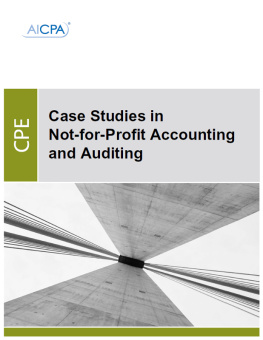
Notice to Readers
Case Studies in Not-For-Profit Accounting and Auditing is intended solely for use in continuing professional education and not as a reference. It does not represent an official position of the American Institute of Certified Public Accountants, and it is distributed with the understanding that the author and publisher are not rendering legal, accounting, or other professional services in the publication. This course is intended to be an overview of the topics discussed within, and the author has made every attempt to verify the completeness and accuracy of the information herein. However, neither the author nor publisher can guarantee the applicability of the information found herein. If legal advice or other expert assistance is required, the services of a competent professional should be sought.
You can qualify to earn free CPE through our pilot testing program. If interested, please visit aicpa.org at http://apps.aicpa.org/secure/CPESurvey.aspx.
20162017 American Institute of Certified Public Accountants, Inc. All rights reserved.
For information about the procedure for requesting permission to make copies of any part of this work, please email copyright@aicpa.org with your request. Otherwise, requests should be written and mailed to Permissions Department, 220 Leigh Farm Road, Durham, NC 27707-8110 USA.
Course Code: 745216
CNFP GS-0416-0B
Revised: May 2016
Chapter 1
F INANCIAL S TATEMENT R EQUIREMENTS
L EARNING O BJECTIVES
After completing this chapter, you should be able to do the following:
- Identify the basic financial statements.
- Determine the basic requirements of the financial statements.
T ECHNICAL B ACKGROUND I NFORMATION
In the list below, the FASB Accounting Standards Codification (ASC) 958, Not-for-Profit Entities, requires not-for-profit entities (NFPs) to present financial statements showing aggregate information about the entity. The general-purpose financial statements required by FASB ASC 958 also include the accompanying notes to the financial statements.
The general-purpose financial statements required by FASB ASC 958 for not-for-profit entities are:
The Statement of Financial Position [May also properly be referred to as a Balance Sheet]
The Statement of Activities
The Statement of Cash Flows
Voluntary health and welfare organizations are also required to present a Statement of Functional Expenses
The Financial Accounting Standards Board's (FASB) Accounting Standards Update (ASU) 2016-14, Presentation of Financial Statements of Not-for-Proft Entities, was released on August 18, 2016. The newly released ASU will change the way all NFPs classify net assets and prepare financial statements. The standard is effective for annual financial statements issued for fiscal years beginning after December 15, 2017 and for interim periods within fiscal years beginning after December 15, 2018. Early application is permitted. For more information visit www.fasb.org.
K NOWLEDGE C HECK
Which is true of the general-purpose financial statements for not-for-profit entities?
a. Voluntary health and welfare organizations are required to present a Statement of Functional Expenses.
b. Not-for-profit entities do not present financial statements showing aggregate information about the entity.
c. The general-purpose financial statements exclude the accompanying notes to the financial statements.
d. The general-purpose financial statements for not-for-profit organizations are the same as for businesses.
The Statement of Financial Position
A statement of financial position reports an entity's assets, liabilities, and net assets. Generally, assets and liabilities should be aggregated into reasonably homogeneous groups. Assets need not be disaggregated based on the presence of donor-imposed restrictions on their use; for example, cash available for unrestricted current use need not be reported separately from cash received with donor-imposed restrictions that is also available for current use. However, cash or other assets either (a) designated for long-term purposes, or (b) received with donor-imposed restrictions that limit their use to long-term purposes should not be aggregated on a statement of financial position with cash or other assets that is available for current use. For example, cash that has been received with donor-imposed restrictions limiting its use to the acquisition of long-lived assets should be reported under a separate caption, such as cash restricted to investment in property and equipment, and displayed near the section of the statement where property and equipment is displayed. The kind of asset should be described in the notes to the financial statements if its nature is not clear from the description on the face of the statement of financial position. As illustrated in the following, assets and liabilities can be presented in a number of ways to provide information about liquidity.
A PPROACHES TO P ROVIDING I NFORMATION ABOUT L IQUIDITY
- Sequencing assets according to their nearness of conversion to cash and sequencing liabilities according to the nearness of their maturity and resulting use of cash.
- Classifying assets and liabilities as current and noncurrent, as defined by the FASB ASC 210, Balance Sheet.
- Disclosing in notes to financial statements relevant information about the liquidity or maturity of assets and liabilities, including restrictions on the use of particular assets.
The statement of financial position should focus on the organization as a whole. It does this by reporting total assets, total liabilities, and total net assets for the organization. Three classes of net assets are required to be reported as unrestricted net assets, temporarily restricted net assets, or permanently restricted net assets.
Information about the nature and amounts of different types of permanent restrictions or temporary restrictions on net assets should be reported either on the face of the statement or in the notes to the financial statement. Separate lines in the statement may be used for permanently restricted net assets to distinguish between holdings (such as land or collections) and endowments.
Separate lines in the financial statements can also be used for temporarily restricted net assets to distinguish among the following types of donor restrictions: support of a particular operating activity, investment for a specified term, use in a specified period, or acquisition of a long-lived asset.
Unrestricted net assets can also use separate lines to report self-imposed limits (designations) on net assets. In cases where separate lines are used in any of the three classes of net assets, a total of aggregate net assets, the sum of all separately stated unrestricted, temporarily restricted, and permanently restricted net assets, must also be shown in the net assets section of the statement of financial position. reports one example of a statement of financial position. Note that this example sequences assets and liabilities based on liquidity and does not display information about the nature of restrictions on the face of the financial statement.
K NOWLEDGE C HECK
Which is true of the statement of financial position?
a. Information about the nature and amounts of different types of permanent restrictions or temporary restrictions on net assets should be either reported on the face of the statement or in the notes to the financial statement.
Next page
















